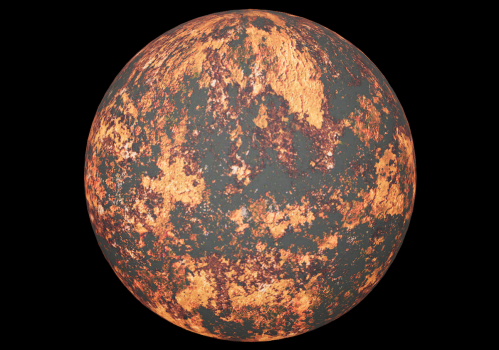Scientists Finally Explain Mysterious Signals From Distant “Hell” Planet

Every so often, a small eclipse, or light signal, becomes visible from Earth. But unlike typical eclipses, this one is not coming from our sun or moon but rather from a mysterious planet 41 light years away. Known as the “hell” planet for its volcano-laden landscape and inferno-like temperatures that reach 4,400 degrees, 55 Cancri e, as it’s scientifically called, was discovered in 2004 and has been baffling scientists ever since. But now, they’ve finally discovered why the planet is giving off these strange signals. Read on for the fascinating explanation.
RELATED: 25 Space Mysteries No One Can Explain.
The “hell” planet is a super-Earth.

The planet is known as a super-Earth, a class of planets that are “more massive than Earth yet lighter than ice giants like Neptune and Uranus,” according to NASA. They can be made of gas, rock, or both.
Super-Earths can be between two and 10 times the size of Earth; 55 Cancri e, which is also known as Janssen, is just over eight times larger, NASA says.
Just as the Earth orbits the Sun, 55 Cancri e orbits its own star, which is roughly the same size as ours. Its star is called Copernicus.
RELATED: You Can See 400,000 “Strikingly Beautiful” Galaxies in This New Map of Space.
This is why it’s so hot.

Though 55 Cancri e was discovered in 2004, it wasn’t until 2016 that NASA’s Spitzer Space Telescope could map the temperature patterns of such a super-Earth. At this time, scientists discovered that lava flows are responsible for “extreme temperature swings from one side of the planet to the other,” explains NASA.
In the case of 55 Cancri e, the hottest side—the “day” side that is facing its star—reaches nearly 4,400 degrees Fahrenheit, while the reverse “night” side is 2,060 degrees Fahrenheit at its coolest. It should also be noted that the planet is “tidally locked,” meaning that the day side is always the day side.
While it takes Earth 365 days to revolve around the sun, 55 Cancri e orbits Copernicus in just 18 days. It also is much closer to its star than the Earth—less than two percent of the distance between Earth and the sun, points out Live Science.
What this means is that 55 Cancri e is more exposed to the heat of its star for more overall time—and this creates a planetary surface that’s “covered in flowing lava seas,” NASA says.
RELATED: The Next Total Solar Eclipse Will Be the Last Until 2044, NASA Says.
A new study explains its light patterns.

Despite understanding the temperature and landscape of 55 Cancri e, scientists remained perplexed by the light it emits. However, a paper recently published in the Astrophysical Journal Letters finally addresses the phenomenon with a new hypothesis.
As Live Science explains, the researchers determined that the planet is “outgassing,” a process in which “giant volcanoes and thermal vents open up, spewing hot carbon-rich elements into the atmosphere.”
But because of the planet’s extreme heat, it “can’t hold on to that atmosphere for long,” Live Science notes, “and this gas eventually gets blown away, leaving the planet bare until the outgassing begins again.”
So, there are times when the planet is “bald” and has no atmosphere at all. During these times, its incredibly hot surface emits infrared light. “When the atmosphere puffs up, both the visible light and all the radiation coming from the surface show up in the transit signal,” sums up Live Science.
RELATED: Intense Solar Storms May Peak Faster Than Expected—What That Means for Earth.
There could be another super-Earth in our galaxy.

All of the other confirmed super-Earths are far outside the Milky Way, but for several years, there’s been a theory that one does exist at the far reaches of our galaxy. Known as Planet Nine, it’s believed to be a trans-Neptunian object (TNO), “small, icy bodies that orbit the sun beyond the orbit of Neptune,” explains Space.com, adding that these are “leftover bits from the formation of the solar system that flung to the outer edges of the system during the chaotic early years of planetary creation.”
However, evidence of Planet Nine is currently based on hypothetical models. “So far, all we have to go on is the strange orbital dance of the dim and distant TNOs,” according to Space.com. “But it’s definitely an intriguing sign and one of the best ways to explain all of the available evidence.”
RELATED: For more up-to-date information, sign up for our daily newsletter.